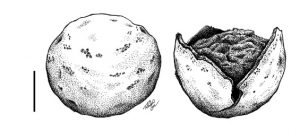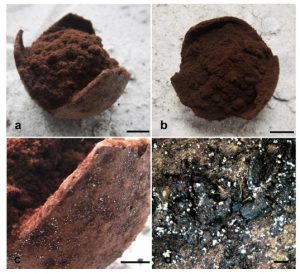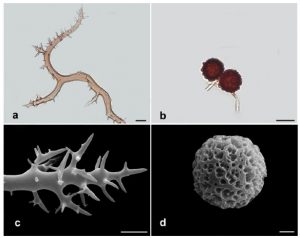Mycenastrum catimbauense Baseia, Gurgel, Melanda, Ferreira R.J. & Alfredo, sp. nov. Index Fungorum number: IF 821075
Etymology – In reference to the type locality, Catimbau National Park, Pernambuco State, Brazil.
Holotype – Brazil, Pernambuco, Buíque, Catimbau National Park (–8°37’0.01″ S –37°08’60.00″ W) on soil, 3 Aug 2006, T. Ottoni (UFRN Fungos – 2847, holotype! UFRN Fungos – 2848).
Diagnosis – Basidiomata 40 mm wide; peridium tomentose, 1.4–2.1 mm thick, grayish brown to dark brown; dehiscence by fragmentation of endoperidium; gleba dark brown; spiny capillitium, brittle thorns; basidiospores globose, 11.7–14.5 μm diam., pedicelate.
Basidiomata at maturity epigeous, 40 mm wide, globose to subglobose (Fig. 2); Subgleba absent; Peridium double 1.4–2.1 mm thick divided into exo– and endo–peridium; Exoperidium persistent, papery, 0.14–0.21 mm thick, tomentose, 0.04–0.08 mm length, dark brown (6F4), pruinose surface and amorphous substance forming flakes; Endoperidium persistent, coriaceous, 1.15–1.77 mm thick, darkish (6F2) to dark brown (6F4), delimited by outer layer 1.1–1.7 mm thick and inner layer 0.02–0.06 mm thick; Dehiscence by rupture of the apical portion of the peridium in irregular pointed rays; Gleba dark brown (6F4), powder releasing easily from peridium. Rhizomorphs not visualized.
Exoperidium composed of interwoven hyphae, 2.6–3.7 [3.13 ± 0.34] μm diam., wall 0.6–1.3 [0.91 ± 0.20] μm thick and tortuous, aseptate, clamp connections absent, reduced lumen, dextrinoid, cyanophilous, yellowish in 5% KOH; Endoperidium composed of outer and inner layer: outer layer, with hyphae (2.4)3.3–5.7 [4.35 ± 0.60] μm diam., wall 0.3–0.7 [0.54 ± 0.08] μm thick, aseptate, clamp connections absent, dextrinoid, yellowish in 5% KOH; inner layer with hyphae 3.2–4.9(6.0) [4.12 ± 0.62] μm diam., wall 0.6–1.3 [0.93 ± 0.15] μm thick, aseptate, clamp connection absent, dextrinoid, cyanophilous, yellowish in 5% KOH; Capillitium 7–15.7 [10.5 ± 1.3] μm diam., aseptate, branched, wall 1.1–2.2 [1.64 ± 0.24] μm thick, spiny capillitium, spines abundant at level of the terminal conical portion, weakly dextrinoid, light brown in 5% KOH, acyanophilous; Spines of capillitium 3.0–15.9 [7 ± 2.8] μm × 1.3–7.3 [2. 8±1.4] μm, brittle, branched; Basidiospores globose to subglobose, 13.3–15.0 × 11.7–14.5 [14.0 ± 0.7 × 13.2 ± 0.7, Qm = 1.1] μm, dextrinoid, acyanophilous, reddish brown in 5% KOH, reticulate and pedicelate.
Habitat – in open soil of ‘Caatinga’ biome dry forest.
Remarks – Mycenastrum catimbauense is a typical species of the genus Mycenastrum. It has a double and thick peridium with the dehiscence occurring from the upper hemisphere, subgleba absent, gleba powdery, spiny capillitium and ornamented basidiospores (Desvaux 1842, Seynes 1869, Long 1930, Bottomley 1948). This species is characterized mainly by its dark tomentose exoperidium, dark brown endoperidium, dark brown gleba (Fig. 3a–d), capillitium with brittle spines (Figs 4a, 4c) and bigger basidiospores measuring 13.3–15.0 μm in diameter (Figs 4b, 4d). These characteristics are closely related to M. corium and M. corium var. diabolicum.
FIGURE. Mycenastrum catimbauense. Illustration of the immature fruiting body and with the gleba exposed. Scale bars: 20 mm.

FIGURE. Basidiomata in situ. a–b. Mature basidiomata with the gleba exposed. c–d. Detailed tomentose exoperidium. Scale bars: a-b = 10 mm, c = 5 mm, d = 0.5 mm

FIGURE. Microstructures. a. Capillitium with brittle spines under LM. b. Basidiospores pedicelate under LM. c. Capillitium with brittle thorns under SEM. d. Basidiospores reticulate under SEM. Scale bars: a= 20 μm, b-c = 10 μm, d = 2 μm.

